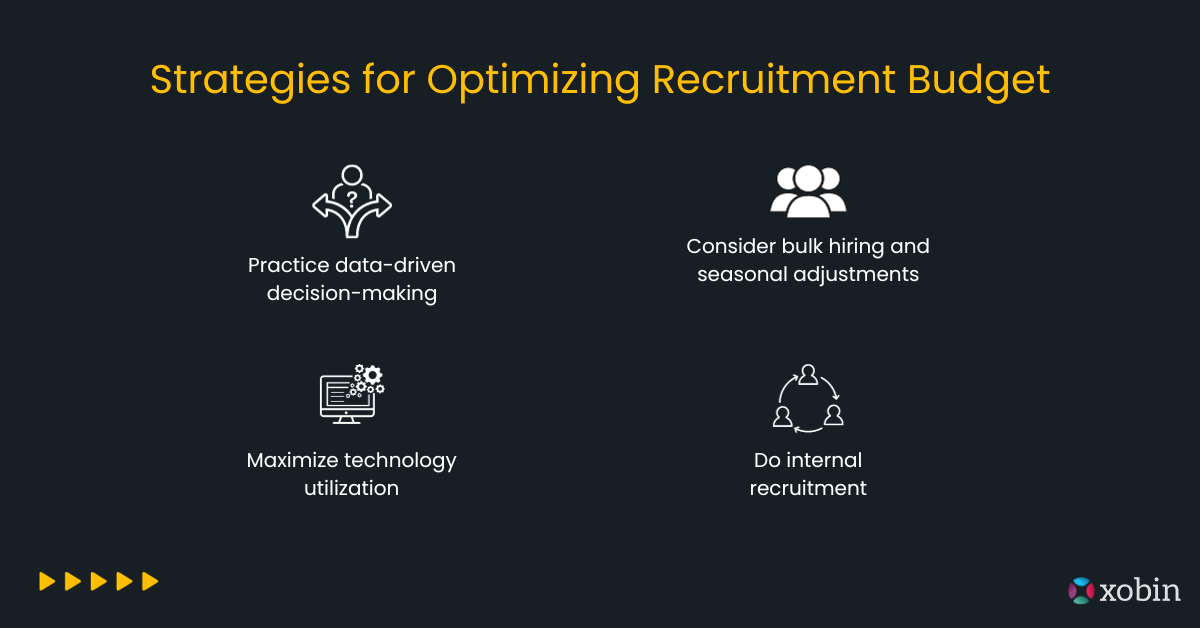Recruiting top talent is critical to an organization’s success. However, the process often comes with its own set of financial challenges. Balancing the need for quality hires against budget constraints is a delicate act, requiring strategic recruitment budget planning and vigilant management. Using pre-employment testing can streamline hiring, ensuring cost-effective decisions without compromising talent quality.
According to the NACE, the overall recruiting budget increased by 51 percent, reaching about $830,000. What do these costs mean, and what do they cover? Let’s dive in.
Table of Contents
Recruitment Budgets are More Than Salaries!
When we think of recruitment costs, the first thing that often comes to mind is the salary package offered to the new hire. However, you can segment the actual expenses involved in recruiting into several categories as follows:
Advertising costs
Fees for posting job advertisements on platforms like Indeed, Glassdoor, or specialized industry sites. While job postings are generally free and unlimited, other additional features may set you back $3,600 to $15,000.
Recruitment agency fees
Recruitment agencies typically charge a fee for their services, which can be a percentage of the hired candidate’s annual salary or a fixed amount. This fee compensates the agency for their expertise, time, and resources invested in sourcing, screening, and presenting suitable candidates. Many recruitment agencies charge a fee as a percentage of the candidate’s first-year salary. This percentage can vary depending on factors like the complexity of the role, industry norms, and the level of specialization required.
Employee referral bonuses
The hiring process can be long and cumbersome, involving multiple rounds of interviews, background checks, and negotiations. Referrals typically speed up this process. An employee vouching for a candidate’s abilities can significantly shorten the initial screening phase. This results in a more streamlined and efficient hiring process. Many companies give bonuses to employees who refer candidates who get hired to encourage referrals.
Screening tools and software
Investment in Applicant Tracking Systems (ATS) and other software for screening applications. It can automate various functions like sorting resumes based on keywords, qualifications, or experience, thus reducing manual screening time. The software can also schedule interviews, send automated responses to candidates, and even integrate with other HR software for seamless data flow.
Onboarding costs
New hires generally require some form of training, whether it’s to get acquainted with company-specific software, protocols, or job-related skills. Training costs can include:
- The materials needed
- The time spent by trainers
- Any specialized courses or certifications the new hire might need
Budgeting should consider both one-time and recurring training expenses. These include employee handbooks, ID badges, and equipment like laptops or phones that a new hire may need. Hence, it’s essential to account for all these aspects when setting your recruitment budget to avoid underestimation and subsequent overspending.
The Hidden Costs: What Often Goes Unnoticed
In addition to the more apparent costs, subtle expenses are easy to overlook but can add up. These include:
- Time spent by current employees: Time spent by HR professionals and department heads on screening resumes, conducting interviews, and training can be significant.
- Cost of a bad hire: The expenses incurred from making a poor hiring decision are not immediate but can be detrimental in the long run. Hiring a candidate unfit for the role and the company can cost anywhere between $17,000 and $240,000.
- Legal costs: Ensuring compliance with local, state, and federal hiring laws requires continuous updating and can incur expenses.
Strategies for Optimizing Recruitment Budget
So, how do you ensure your recruitment process matches your budget? Here are some tips:

Practice data-driven decision-making
This strategy involves leveraging data and analytics to inform recruitment decisions. By analyzing metrics such as cost per hire, time to fill, and source effectiveness, organizations can identify the most efficient and cost-effective recruitment channels. This allows for a more targeted allocation of resources towards channels that yield the best results, ultimately maximizing the ROI on recruitment spending.
Consider bulk hiring and seasonal adjustments
Bulk hiring refers to the practice of recruiting multiple candidates for similar roles within a relatively short time frame. This approach can lead to economies of scale, as the cost per hire tends to decrease when hiring in larger quantities. Additionally, seasonal adjustments involve ramping up recruitment efforts during periods of high demand and scaling back during slower periods. This flexible approach ensures that resources are allocated where they are most needed, optimizing budget utilization.
Maximize technology utilization
Embracing recruitment technologies, such as applicant tracking systems (ATS), AI-powered screening tools, and job posting platforms, can significantly streamline the hiring process. These technologies automate administrative tasks, improve candidate sourcing, and enhance candidate experience. By reducing manual efforts and improving efficiency, organizations can achieve cost savings while maintaining or even improving the quality of hires.
Do internal recruitment
Internal recruitment involves filling job vacancies with existing employees. This can be a cost-effective strategy as it eliminates many of the external costs associated with traditional hiring, such as advertising, agency fees, and onboarding expenses. Additionally, internal hires often require shorter training periods and are already familiar with the company culture, potentially leading to faster productivity.
Best Practices for Managing Recruitment Budget
Managing a recruitment budget is not a one-time activity but an ongoing process that requires diligence, communication, and flexibility. Below are some best practices that can guide you in effectively managing your recruitment budget:
Conduct regular auditing
Consistently reviewing your budget against actual spending helps identify discrepancies and correct them in real-time. This process involves reviewing invoices, receipts, and other financial documentation related to recruitment activities.
Hence, choose a specific timeframe for auditing—weekly, bi-weekly, or monthly. You can also use a finance tracker with integration capabilities for real-time tracking. It will also help to have a dedicated person responsible for this auditing process.
Improve stakeholder communication
Regularly update all stakeholders involved in the recruitment process on budget usage and any required changes. Set up regular budget meetings with all stakeholders involved. Use dashboards that can be easily shared and understood to display budget metrics.
Most importantly, establish clear channels for immediate communication on any significant budget changes or concerns.
Do contingency planning
Even with the most meticulous planning, unexpected costs are almost inevitable. These can arise from various factors, such as a sudden need for specialized talent, increased competition driving up salaries, or even unexpected turnover requiring swift replacements. So, having a contingency fund helps absorb these unforeseen costs, preventing disruptions in the recruitment process. You avoid the need to divert funds from other essential activities.
Estimate a reasonable contingency amount based on past recruitment cycles and the scale of your hiring needs. Segregate this fund from the main recruitment budget to avoid accidental spending. Establish strict guidelines on what constitutes an “unexpected” cost that warrants dipping into the contingency fund.
Final Thoughts
Managing a recruitment budget is not a set-it-and-forget-it task. It requires ongoing evaluation, strategic planning, and quick adaptation to changing circumstances. Armed with these guidelines and best practices, take the time today to evaluate your current recruitment budget. Look for optimization opportunities that balance cost-effectiveness with the quality of hires to ensure long-term success for your organization.






